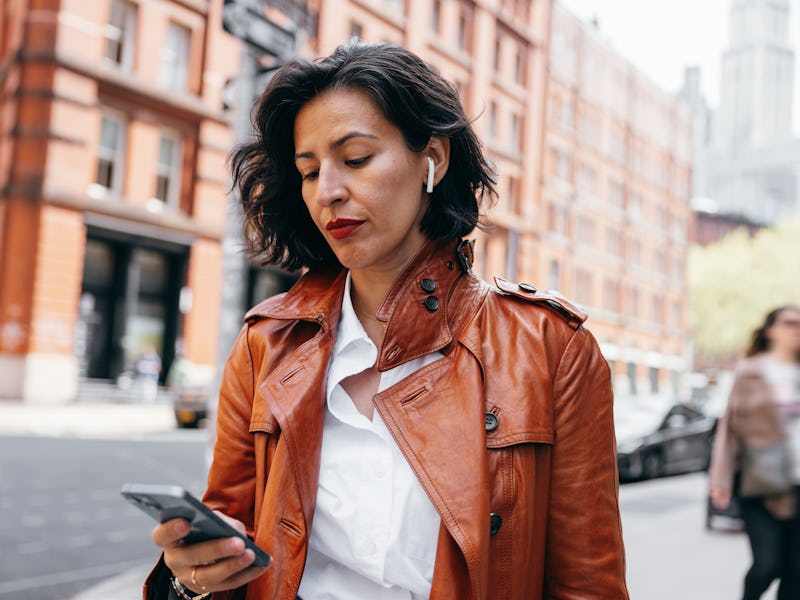Do Airpods Cause Hearing Loss? This Science-Backed Trick Will Protect Your Ears
If you listen to music in your earbuds for hours at a time, we’ve got some bad news.

On any city street, you’re bound to see every type of person, from finance bros to artsy hipsters, making their way downtown from within the protective bubble of their headphones or earbuds. We may all appear separated by our preferences for AirPods or headphones, Bluetooth or wired, but at the end of the day, we’re all conjuring a private oasis in the most public spaces.
But like any good thing, too much comes with consequences. In fact, the possibility of hearing damage from excessive vibing in your head is so serious that in 2022 the World Health Organization (WHO) released recommendations to limit listening time in order to prevent loss.
Here’s what you should know about what listening to 8 hours of Taylor Swift daily is doing to our eardrums (and that’s before blowing out our cochleas at the Eras tour). Clinical audiologist Will Stoll at Hackensack Audiology lays out what happens when we listen to music all day, every day — and available alternatives if we so choose.
The eardrum dance
Music is soundwaves, Stoll wrote in an email to Inverse, which results in vibrations in the air. The waves wiggle through the air into our ear canal, which is the passage leading from the outer ear to the middle ear. Upon reaching the ear canal, the vibrations continue toward the eardrum (a.k.a. The tympanic membrane), which is a thin, supple membrane that shields the middle ear from the outer ear.
Sound waves cause the eardrum to vibrate. These vibrations travel to three little bones in the middle ear called the ossicles. These bones amplify and transmit the vibrations, finally, to the inner ear, where they shimmy to the spiral-shaped cochlea. Fluid in the cochlea sways with the vibrations, stimulating thousands of little hairs.
Those microscopic hairs convert the vibrations-turned-fluid-motion into electrical signals, which zap to the auditory nerve. The auditory nerve ferries those electrical signals to the brain, resulting in sweet, sweet music.
“As we increase or decrease volume, we experience a change in these vibrations and the stimulation of our hearing nerves traveling up to our brain,” Stoll says.
However, as we age, gradual hearing loss pervades the inner ear in a process called presbycusis. “Over time, loud noises can damage your sensory hair cells, which is one of the parts of your ear that allows hearing,” Stoll says. While hearing loss is simply a part of aging, overall health, lifestyle choices, and environmental factors can influence this progression. Diabetes, high blood pressure, and a family history of hearing loss all weigh more heavily on this loss.
What volume should you keep your earbuds at?
Stoll outlines that there’s no hard and fast rule for safe listening. But he does have a recommendation that some music diehards may find disappointing.
“There is no “safest” volume per se, but when possible, it is recommended that people follow the 60/60 rule: Set your volume at 60 [percent] of the maximum level and listen at a maximum of 60 minutes at a time,” he says.
Setting volume is highly variable depending on how soft the music you’re listening to is, its quality, and generally how locked into your own head you want to be. We all know that guy who listened to symphonic metal so loud that everyone on the train could hear it, too.
However, “sound at a high volume can damage the hair cells of the inner ear and the auditory nerve,” he says. In addition to the 60/60 rule, Stoll recommends taking breaks from listening, which allows us to enjoy our favorite music longer. Symptoms like tinnitus (a ringing in the ears) could be a warning sign of ear damage, and listeners ought to lower the volume.
What’s safer: Over-ear or in-ear headphones?
There’s also a difference between over-ear headphones and in-ear buds. In-ear buds seal the ear canal from outside sound, which should mean that the listener doesn’t need such a high volume. Stoll also offers a fun little experiment for folks to experience how sealing the ear canal changes the resonant properties, resulting in greater response to bass frequencies below 1000 Hertz (Hz), which is the measure of frequency.
If you place your fingers in your ears, he says, you’ll “hear these low vowel sounds much louder with the canal closed.”
There’s also decibels (dB), which measure amplitude. If music is a sound wave, then a Hertz is how long it takes for one wave to complete. A decibel is how high or low those waves reach. Soft breathing reaches 10 dB, according to the WHO, while firecrackers reach 150 dB. Headphones and earbuds can max out at 100 dB or more.
Listening gear isn’t only for music, of course. Stoll says that podcasts contain less “constant sound energy” than music recordings. The natural pauses and cadences of a podcast conversation aren’t as hard on the ears as a relentless piece of music, dense with sound. But that shouldn’t influence what we listen to so much as how we listen to it.
“Despite this small difference, the overall volume is what we should consider the most,” Stoll says.
The price of excessive vibing is still unknown
Stoll says that it’s difficult to experimentally study adults’ listening habits over time. Self-reported studies, which aren’t necessarily as precise and reliable as controlled clinical studies, demonstrate a relationship between individual listening habits and hearing loss, especially at the highest frequencies.
Everyone deserves to vibe; but also: Vibe safely.
This article was originally published on